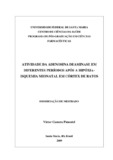Mostrar el registro sencillo del ítem
Atividade da adenosina deaminase em diferentes períodos após a hipóxia-isquemia neonatal em córtex de ratos
| dc.creator | Pimentel, Victor Camera | |
| dc.date.accessioned | 2009-09-29 | |
| dc.date.available | 2009-09-29 | |
| dc.date.issued | 2009-07-14 | |
| dc.identifier.citation | PIMENTEL, Victor Camera. Adenosine deaminase activity in different periods after neonatal hypoxic-ischemic in cortex of rats. 2009. 85 f. Dissertação (Mestrado em Farmacologia) - Universidade Federal de Santa Maria, Santa Maria, 2009. | por |
| dc.identifier.uri | http://repositorio.ufsm.br/handle/1/5888 | |
| dc.description.abstract | Neonatal hypoxic-ischemic injury (HI) is the direct complication to severe choking and may cause brain damage. HI may be found in different stages and clinical manifestations contributing to neonatal morbidity and mortality. The neuropathology of neonatal HI insult is multi-factorial and complex. Hypoxic-ischemic brain damage begins during the insult and extends during the recovery period after reperfusion, thus, it is an evolutionary process. Adenosine deaminase (ADA) is an aminohidrolase actively involved in the metabolism of purines catalyzing irreversibly adenosine and 2'desoxiadenosine into inosine and 2'desoxinosine, respectively. The objectives of this study were to evaluate the activity of ADA in the cortex of rats subjected to neonatal HI at different post-insult time points. Effects of thiobarbituric acid reactive species (TBARS) levels were also assessed in cortex. The histological analysis was evaluated using hematoxylin eosin (HE) and glial fibrillary acidic protein (GFAP) in the cortex of these animals. The ADA activity was significantly increased 8 days after the insult in the left hemisphere in the cortex. In this period, TBARS levels were significantly increased in the cortex of these animals. HE revealed the presence of ischemic area in the cerebral cortex 8 days after HI. A moderate lymphocytic infiltration was also evidenced in the cortex during this period. A proliferation and an increase in the expression of GFAP in the periphery of the ischemic area was observed, resulting in astrocytosis in the cortex of these animals. In conclusion, an activation of the immune system was observed due to the inflammatory process caused by the HI insult that may be correlated with astrocytosis and lymphocytic infiltration observed in the cerebral cortex of animals that suffered insult 8 days after neonatal HI. | eng |
| dc.description.sponsorship | Coordenação de Aperfeiçoamento de Pessoal de Nível Superior | |
| dc.format | application/pdf | por |
| dc.language | por | por |
| dc.publisher | Universidade Federal de Santa Maria | por |
| dc.rights | Acesso Aberto | por |
| dc.subject | Hipóxia isquemia | por |
| dc.subject | Adenosina deaminase | por |
| dc.subject | Córtex | por |
| dc.subject | Peroxidação lipídica | por |
| dc.subject | GFAP | por |
| dc.subject | Hypoxic ischemia | eng |
| dc.subject | Adenosine deaminase | eng |
| dc.subject | Cortex | eng |
| dc.subject | Lipid peroxidation | eng |
| dc.subject | GFAP | eng |
| dc.title | Atividade da adenosina deaminase em diferentes períodos após a hipóxia-isquemia neonatal em córtex de ratos | por |
| dc.title.alternative | Adenosine deaminase activity in different periods after neonatal hypoxic-ischemic in cortex of rats | eng |
| dc.type | Dissertação | por |
| dc.description.resumo | A lesão hipóxico-isquêmica (HI) neonatal é a complicação imediata à asfixia grave e pode causar dano cerebral. A HI pode apresentar-se em diferentes estágios e manifestações clínicas contribuindo assim intensamente na morbidade e mortalidade neonatal. A neuropatologia do insulto HI neonatal é multi-fatorial e complexa. O dano cerebral hipóxicoisquêmico inicia durante o insulto e estende-se no período de recuperação após a reperfusão, portanto é um processo evolutivo. A adenosina deaminase (ADA) é uma aminohidrolase que participa ativamente do metabolismo das purinas catalisando irreversivelmente a adenosina e 2 desoxiadenosina em inosina e 2 desoxinosina, respectivamente. Os objetivos deste estudo foram avaliar em ratos submetidos à HI neonatal a atividade da ADA no córtex destes animais em diferentes tempos pós-insulto. Também foram avaliados em córtex os efeitos dos níveis de espécies reativas ao ácido tiobarbitúrico (TBARS). A análise histológica foi avaliada através da hematoxilina eosina (HE) e proteína glial fibrilar ácida (GFAP) no córtex destes animais. A atividade da ADA aumentou significativamente 8 dias após o insulto no hemisfério esquerdo no córtex. Neste período os níveis de TBARS mostraram-se significativamente aumentados no córtex destes animais. A HE revelou presença de área isquêmica no córtex cerebral 8 dias após a HI. Também evidenciou uma moderada infiltração linfocitária no córtex neste período. Houve proliferação e aumento na expressão da GFAP na periferia da área isquêmica, resultando em astrocitose no córtex dos animais submetidos à HI. Conclui-se que houve uma ativação do sistema imune em decorrência do processo inflamatório causado pelo insulto HI que pode estar correlacionada com a astrocitose e a infiltração linfocitária observada no córtex cerebral dos animais que sofreram o insulto 8 dias após a HI neonatal. | por |
| dc.contributor.advisor1 | Moretto, Maria Beatriz | |
| dc.contributor.advisor1Lattes | http://lattes.cnpq.br/7317262818918502 | por |
| dc.contributor.referee1 | Rubin, Maribel Antonello | |
| dc.contributor.referee1Lattes | http://lattes.cnpq.br/7237734243628134 | por |
| dc.contributor.referee2 | Mello, Carlos Fernando de | |
| dc.contributor.referee2Lattes | http://lattes.cnpq.br/3913887223894236 | por |
| dc.creator.Lattes | http://lattes.cnpq.br/8245775510758198 | por |
| dc.publisher.country | BR | por |
| dc.publisher.department | Análises Clínicas e Toxicológicas | por |
| dc.publisher.initials | UFSM | por |
| dc.publisher.program | Programa de Pós-Graduação em Ciências Farmacêuticas | por |
| dc.subject.cnpq | CNPQ::CIENCIAS DA SAUDE::FARMACIA | por |
Ficheros en el ítem
Este ítem aparece en la(s) siguiente(s) colección(ones)
-
Programa de Pós-Graduação em Ciências Farmacêuticas [328]
Coleção de dissertações do Programa de Pós-Graduação em Ciências Farmacêuticas


